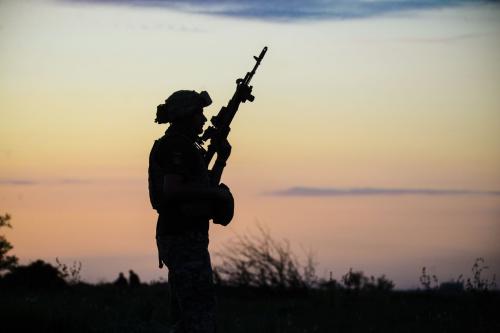In the two months since the New START Treaty (Strategic Arms Reduction Treaty) was signed by Presidents Obama and Medvedev, critics have raised a number of questions about its terms and impact. So far, however, they have raised no substantive objection that could sink the treaty’s ratification prospects.
New START will reduce U.S. and Russian strategic warheads to a level of 1550—a cut of about 30 percent from what the sides were previously allowed. The treaty also sets limits on intercontinental ballistic missiles (ICBMs), submarine-launched ballistic missiles (SLBMs) and nuclear-capable bombers. These limits will bring U.S. and Russian strategic nuclear forces to their lowest levels in 40 years.
The Senate Foreign Relations Committee opened Senate review of the treaty on May 18. In the weeks since the treaty text was released in April, we have already seen the principal questions of treaty critics. What are the objections? What are the responses?
First, New START will limit missile defense and/or weaken the U.S. commitment to missile defense
. The treaty’s preamble notes the interrelationship between offense and defense, simply stating the reality that one side’s missile defense can affect the other side’s offensive forces. As for hard limits, the treaty contains only one regarding missile defense: the United States would be barred from placing missile defense interceptors in ICBM silos or SLBM launchers. That’s a constraint, but not one that will affect the U.S. missile defense program. The Pentagon has no plans to put missile interceptors in ICBM or SLBM launchers; it would be cheaper to build new silos for missile defense interceptors than convert existing ICBM silos.
In connection with New START’s signature, the Russians issued a unilateral statement suggesting that Moscow would consider withdrawing from the treaty if a U.S. missile defense build-up were to threaten Russia’s strategic offensive forces, something that the treaty allows Russia (and the United States) to do on three months’ notice. Some critics worry this could be used to blackmail the administration into scaling back its missile defense plans. The Russians made a similar statement when signing the START I Treaty in 1991, but they did not withdraw from that treaty—even when the Bush administration withdrew from the Anti-Ballistic Missile Treaty in 2002.
Second, conventional warheads on ICBMs and SLBMs will count under New START’s limit of 1550 strategic warheads
. At present the United States deploys nuclear warheads on its strategic missiles. It has considered a program—Precision Global Strike—to put conventional warheads on its ICBMs or SLBMs. Were that program to go forward, those conventional warheads would count. But the number of such warheads would be small; the Bush administration plan envisaged less than 30, just a tiny fraction of the 1550 permitted warheads. Why would the number of conventional warheads be so small? An ICBM or SLBM is an awfully expensive way to deliver a conventional warhead to a target—Trident D-5 SLBMs, for example, cost 130 million dollars each—and scenarios where other, more cost-effective means would not suffice are limited.
Third, New START counts heavy bombers as carrying only one warhead each
. Neither the U.S. nor Russian air forces normally maintain nuclear weapons on bombers. The negotiators thus agreed that each nuclear-capable bomber would count as carrying one weapon, even though they can carry more (this is in contrast to the counting rule for ICBMs and SLBMs, which will count the actual number of warheads on those missiles). The one weapon-per-bomber rule is not a limit; it is a counting device. Moreover, the U.S. Air Force has nearly three times as many bombers as Russia. Although many U.S. bombers have been converted to conventional-only roles, the Pentagon plans to maintain 60 nuclear-capable bombers—about equal to the entire Russian bomber inventory.
Securing preferential treatment for bombers has been a central goal of U.S. arms control policy for 40 years. For example, the Reagan administration’s original START proposal contained no limits on bombers. The rationale is that bombers, due to their long flight times (as much as eight-twelve hours), cannot be used in a surprise attack.
Fourth, New START does not reduce tactical nuclear weapons, where Russia has a significant numerical advantage
. That is correct, but the Obama administration has stated that it will address tactical nuclear weapons in the next round of negotiations. A failure to ratify New START would not make securing Russian agreement to reductions in tactical nuclear weapons any easier. The countries most exposed to Russia’s tactical nuclear arsenal—NATO allies in Europe—support New START.
Fifth, New START streamlines or weakens the verification provisions from START I, particularly with regard to telemetry and monitoring mobile ICBMs
. Telemetry is the information a ballistic missile broadcasts during a test flight. START I required that all telemetry be shared with the other side. New START provides that the sides exchange telemetry on up to five tests per year, but it views telemetry as a transparency measure rather than a verification provision. The United States does not need access to any telemetry in order to monitor Russian treaty compliance. That’s because New START does not contain the START I limits that required telemetry for verification.
The more serious question has to do with monitoring mobile ICBMs on trucks. Under START I, U.S. inspectors were located at the Votkinsk missile production plant, where Russia builds its mobile ICBMs, and could count missiles as they emerged. The Bush administration agreed to forgo monitoring at Votkinsk and, in the New START talks, the Russians rejected such monitoring. New START’s combination of data exchange, data updates, unique identifiers on missiles and associated launchers, movement notifications and inspections, coupled with use of U.S. national technical means of verification such as imagery satellites, should allow the United States to monitor the Russian mobile ICBM force and detect any significant violation before it could jeopardize U.S. security.
Sixth, the Russians fooled U.S. negotiators by not defining a rail-mobile ICBM launcher, thereby creating a loophole for future exploitation
. The Russians retired their rail-mobile ICBMs—which had been manufactured in Ukraine when it was still a part of the Soviet Union—several years ago. In the unlikely event that they choose to revive the program and build rail-mobile ICBMs in Russia, New START defines and limits both ICBMs and ICBM launchers. So the Russian systems would be captured, even without a specific definition of a rail-mobile ICBM launcher.
Seventh, U.S. strategic forces could atrophy under New START
. New START does not inhibit the U.S. ability to modernize its strategic nuclear forces within the treaty’s numerical limits. The administration announced on May 13 a plan over the next ten years to devote 80 billion dollars to the nuclear weapons complex in order to maintain the nuclear stockpile, and 100 billion dollars to sustain and modernize strategic delivery systems. The United States plans to retain a very robust strategic nuclear deterrent.
Those who criticize New START have failed so far to make a substantive case against its ratification. That may be one reason why Republican senators have raised questions about the treaty, but only one has declared that he will outright oppose it. Some critics appear to be grasping for reasons to say no. For example, former Under Secretary of State Bolton criticized New START for not limiting tactical nuclear weapons, for “confusingly” mixing counting rules, and for giving up some of START I’s verification measures. When in the Bush administration, Mr. Bolton was the chief negotiator of the 2002 Strategic Offensive Reductions Treaty. That agreement did not limit tactical nuclear weapons, had no counting rules, and had no verification measures.
Should New START become a political football, subject to the kind of partisan fighting that characterized the health care debate, all bets on ratification are off. But the Senate thus far appears to be approaching the treaty in the spirit of weighing what is in the national interest. If that spirit holds and the Senate judges the treaty on its merits, we should expect Senate consent to New START’s ratification.



Commentary
Op-edNew START—No Killer Flaws Emerge
June 4, 2010